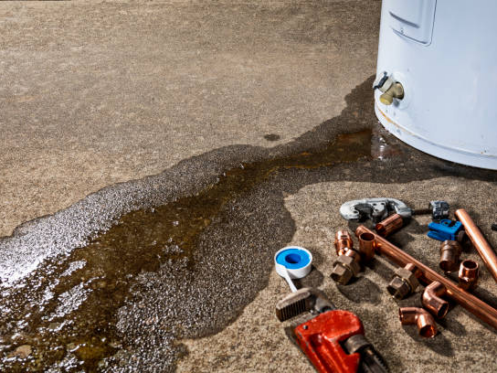Hot water heaters are essential for maintaining a comfortable home, but when they start leaking, it can quickly become a major concern. Leaks from the top of a hot water heater are particularly important to address promptly to prevent further damage and costly repairs. This guide will help you understand the common causes of these leaks, how to fix them, and how to prevent future issues. We’ll also discuss related topics like leaks from the bottom of the heater and general maintenance tips, ensuring you have all the information you need to keep your water heater in top shape.
Common Causes of Hot Water Heater Leaking from Top
Leaks from the top of a hot water heater can occur for several reasons. Understanding these causes can help you address the issue quickly and effectively:
- Loose Connections: Over time, the connections at the top of the water heater can become loose due to vibrations and thermal expansion. This can lead to water seeping out.
- Faulty Valves: The temperature and pressure relief valve, or T&P valve, is designed to release water if the pressure or temperature gets too high. If this valve is faulty, it may leak even when conditions are normal.
- Corrosion: Corrosion can occur around the inlet or outlet pipes, weakening connections and causing leaks. It can also affect the water tank over time, leading to leaks, particularly at the bottom where sediment can build up and cause rust.
These issues can often be detected early by paying attention to warning signs.
How to Fix a Hot Water Heater Dripping from Top
Discovering a hot water heater dripping from the top can be alarming, but with the right steps, you can address the issue efficiently. Here’s a simple guide to help you manage this common problem:
- Turn Off the Power: For electric heaters, switch off the power at the circuit breaker. For gas heaters, set the thermostat to the lowest setting and turn off the gas supply.
- Check for Loose Connections: Inspect the pipes and connections at the top of the heater. Use a wrench to tighten any loose fittings carefully.
- Inspect the Temperature and Pressure Relief Valve: This valve releases excess pressure. If it’s leaking, it might need replacement. Ensure the valve is tightly closed, and if the leak persists, consider replacing it.
- Examine the Cold Water Inlet Valve: A faulty inlet valve can cause leaks. Check for drips and replace the valve if necessary.
- Safety First: Always prioritize safety when dealing with water heaters. Avoid direct contact with hot water and seek professional help if you’re unsure about the repairs.
- When to Call a Professional: If the leak continues after these checks, it might indicate a more serious issue. Contact a professional plumber to assess and fix the problem.
Understanding Hot Water Tank Leaking Water
While top leaks are common, it’s important to understand other potential leak points on your water heater. Here’s what you need to know:
- Tank Damage: Any physical damage to the tank, such as dents or punctures, can result in leaks. Regular inspection can help catch these issues early.
- Pipe Fittings: Leaks can also occur at the joints where pipes connect to the tank. Ensure these are properly sealed and tightened.
For a clear understanding, imagine the water heater as a system where each component must be intact to prevent leaks. Regular maintenance and inspection can help avoid these issues. For detailed maintenance tips, refer to this guide from Lowe’s.
Preventive Measures and Maintenance Tips
Keeping your hot water heater in good condition is essential to avoid leaks and extend its lifespan. Here are some practical tips to help you maintain your water heater:
- Regular Inspections: Check your water heater regularly for any signs of wear or leaks. Look for rust, corrosion, or any water pooling around the unit.
- Flush the Tank: Sediment can build up in the tank over time, potentially causing damage. Flushing the tank yearly can help prevent this. For detailed instructions, refer to Maintain a Water Heater.
- Test the Pressure Relief Valve: Test the pressure relief valve at least once a year to ensure it’s functioning correctly. This valve is crucial for releasing excess pressure from the tank.
- Insulate the Heater: Insulating your water heater can improve efficiency and reduce the risk of condensation, which can lead to rust and leaks.
- Adjust the Temperature: Keep the thermostat at a safe level, ideally around 120 degrees Fahrenheit, to prevent overheating and reduce energy costs.
By following these maintenance tips, you can help prevent leaks and keep your hot water heater running smoothly for years to come.
The Role of Regular Plumbing Inspections
Regular plumbing inspections are a proactive way to prevent leaks and other plumbing issues in your home. Here’s why they are important:
- Early Detection: Inspections can identify potential problems before they become major issues, saving you time and money on repairs.
- Comprehensive Check: A professional plumber will check all components of your plumbing system, including your water heater, to ensure everything is in good working order.
- Peace of Mind: Knowing that your plumbing system is in top condition provides peace of mind and helps maintain a comfortable living environment.
For more insights on the importance of regular plumbing inspections, visit The Importance of Regular Plumbing Inspections.
Regular maintenance and inspections are key to preventing leaks and ensuring the longevity of your hot water heater. Quality Cooling and Heating is here to help with all your HVAC and plumbing needs. Contact us for more information or to schedule a service.
What to Do When Water Heater Dripping from Bottom
Experiencing a water heater dripping from the bottom can be concerning, but understanding the causes and solutions can help you address the issue effectively. Here are some common reasons and steps you can take:
- Condensation: Sometimes, what appears as a leak might just be condensation. Check if the dripping is consistent or if it happens only when the heater is actively heating water.
- Drain Valve Leak: The drain valve at the bottom of the tank can become loose or faulty over time. Ensure it is tightly closed, and if it continues to leak, consider replacing it.
- Tank Corrosion: If the tank itself is leaking due to corrosion, it may need to be replaced. Look for rust or discoloration around the base of the tank.
To address these issues:
- Turn off the power supply to the water heater to ensure safety.
- Inspect the drain valve and tighten it if necessary. If it’s damaged, replace it with a new one.
- Check the pressure relief valve, as it might also cause leaks if it’s faulty.
If the problem persists or if you notice significant water pooling, it’s crucial to contact a professional plumber. Quality Cooling and Heating offers expert plumbing services and can help diagnose and fix the issue efficiently. Visit our website for more information.
Conclusion: Ensuring Your Home’s Comfort and Safety
Addressing leaks in your hot water heater promptly is essential to maintaining a safe and comfortable home environment. Whether dealing with a hot water heater leaking from the top or bottom, understanding the causes and solutions is key to preventing further damage.
Regular maintenance and inspections can help extend the life of your water heater and prevent unexpected issues. If you encounter persistent problems, don’t hesitate to seek professional help. Quality Cooling and Heating is here to assist with all your HVAC and plumbing needs, offering reliable services in the Greater Austin and Abilene areas. For urgent issues, our emergency services are just a call away. Visit our website to learn more about how we can help ensure your home remains comfortable and safe.


